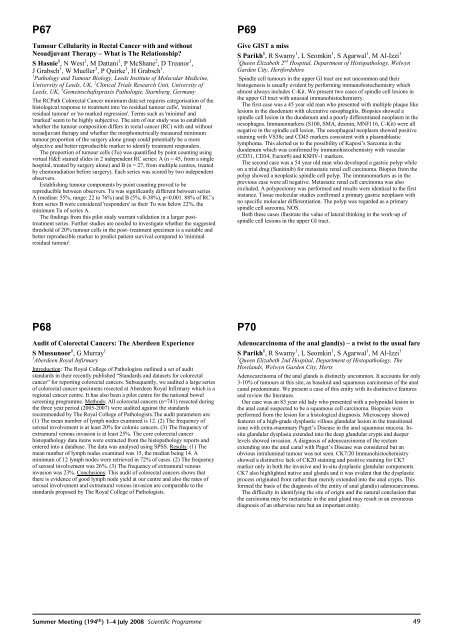2008 Summer Meeting - Leeds - The Pathological Society of Great ...
2008 Summer Meeting - Leeds - The Pathological Society of Great ...
2008 Summer Meeting - Leeds - The Pathological Society of Great ...
You also want an ePaper? Increase the reach of your titles
YUMPU automatically turns print PDFs into web optimized ePapers that Google loves.
P67Tumour Cellularity in Rectal Cancer with and withoutNeoadjuvant <strong>The</strong>rapy – What is <strong>The</strong> Relationship?SHasnie 1 ,NWest 1 ,MDattani 1 , P McShane 2 , D Treanor 1 ,J Grabsch 1 , W Mueller 3 ,PQuirke 1 , H Grabsch 1 .1 Pathology and Tumour Biology, <strong>Leeds</strong> Institute <strong>of</strong> Molecular Medicine,University <strong>of</strong> <strong>Leeds</strong>, UK, 2 Clinical Trials Research Unit, University <strong>of</strong><strong>Leeds</strong>, UK, 3 Gemeinschaftspraxis Pathologie, Starnberg, Germany<strong>The</strong> RCPath Colorectal Cancer minimum data set requires categorisation <strong>of</strong> thehistological response to treatment into 'no residual tumour cells', 'minimalresidual tumour' or 'no marked regression'. Terms such as 'minimal' and'marked' seem to be highly subjective. <strong>The</strong> aim <strong>of</strong> our study was to establishwhether the tumour composition differs in rectal cancer (RC) with and withoutneoadjuvant therapy and whether the morphometrically measured minimumtumour proportion <strong>of</strong> the surgery alone group could potentially be a moreobjective and better reproducible marker to identify treatment responders.<strong>The</strong> proportion <strong>of</strong> tumour cells (Tu) was quantified by point counting usingvirtual H&E stained slides in 2 independent RC series: A (n = 45, from a singlehospital, treated by surgery alone) and B (n = 27, from multiple centres, treatedby chemoradiation before surgery). Each series was scored by two independentobservers.Establishing tumour components by point counting proved to bereproducible between observers. Tu was significantly different between seriesA (median: 55%, range: 22 to 76%) and B (5%, 0-38%), p













